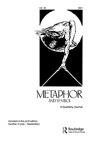Mental Simulation in the Processing of Literal and Metaphorical Motion Language: An Eye Movement Study
IF 3.3
3区 文学
0 LANGUAGE & LINGUISTICS
引用次数: 2
Abstract
ABSTRACT An eye-tracking while listening study based on the blank screen paradigm was conducted to investigate the processing of literal and metaphorical verbs of motion. The study was based on two assumptions from the literature: that language comprehension by default engages mental simulation, and that looking behavior (measured through patterns of eye movements) can provide a window into ongoing cognitive processes. This study specifically compared the comprehension of sentences that depicted actual physical motion (the curtain is rising) and sentences that described changes in quantity or emotional states in terms of vertical motion (prices are rising). Results showed that eye movements were selectively biased upward or downward in accordance with the direction implied by the verb, regardless of the context (literal or metaphorical) in which they appeared, and in the absence of any visual stimuli or explicit task. Thus, these findings suggest that literal and metaphorical language drive spontaneous, direction-specific mental simulations captured by eye movements and that at least in the case of verbs presented in the present progressive, which emphasizes the ongoing nature of actions, visual biases along the vertical axis may start during the verb itself.动作语言加工过程中的心理模拟——眼动研究
摘要:本研究基于空白屏幕范式进行了听力时眼动追踪研究,以研究动作的字面和隐喻动词的加工。这项研究基于文献中的两个假设:默认情况下,语言理解涉及心理模拟,而注视行为(通过眼动模式测量)可以提供一个了解正在进行的认知过程的窗口。这项研究特别比较了描述实际身体运动(帷幕升起)的句子和描述垂直运动(价格上涨)的数量或情绪状态变化的句子的理解力。结果表明,在没有任何视觉刺激或明确任务的情况下,无论出现的上下文(字面或隐喻)如何,眼球运动都会根据动词所暗示的方向选择性地向上或向下倾斜。因此,这些发现表明,字面和隐喻语言驱动着通过眼动捕捉到的自发的、特定方向的心理模拟,至少在强调动作进行性的现在进行式中出现的动词的情况下,沿着纵轴的视觉偏见可能始于动词本身。
本文章由计算机程序翻译,如有差异,请以英文原文为准。
求助全文
约1分钟内获得全文
求助全文
来源期刊

Metaphor and Symbol
Multiple-
CiteScore
2.90
自引率
0.00%
发文量
23
期刊介绍:
Metaphor and Symbol: A Quarterly Journal is an innovative, multidisciplinary journal dedicated to the study of metaphor and other figurative devices in language (e.g., metonymy, irony) and other expressive forms (e.g., gesture and bodily actions, artworks, music, multimodal media). The journal is interested in original, empirical, and theoretical research that incorporates psychological experimental studies, linguistic and corpus linguistic studies, cross-cultural/linguistic comparisons, computational modeling, philosophical analyzes, and literary/artistic interpretations. A common theme connecting published work in the journal is the examination of the interface of figurative language and expression with cognitive, bodily, and cultural experience; hence, the journal''s international editorial board is composed of scholars and experts in the fields of psychology, linguistics, philosophy, computer science, literature, and media studies.
 求助内容:
求助内容: 应助结果提醒方式:
应助结果提醒方式:


